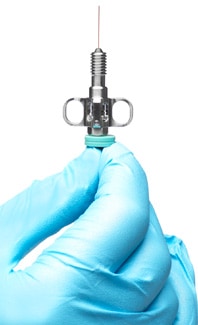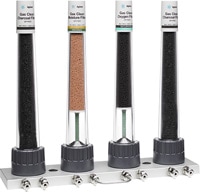Access Agilent eNewsletter, May 2014
>> Update My Profile | Subscribe to Access Agilent | Article Directory

Tips and tricks for better gas chromatography connections
By Ken Lynam
Agilent GC Applications
There are several checkpoints in your gas chromatography (GC) system where connections are made, and each one can be a source of leaks and lead to poor chromatography. That’s why inspecting the connections in your GC is key to good preventive maintenance – and a laboratory practice that you simply cannot afford to overlook. Poor, leaky connections can cause:
- Noisy baselines
- Loss of expensive, high-quality gas
- Shorter column and detector life
- Decreased system sensitivity
- Reduced system productivity
Agilent has published a handy wall chart that highlights critical GC connections. The wall chart’s five tips and tricks will help you avoid common connection problems. Here’s just a taste of what you will learn…
1. Choose the right ferrules and nuts

Figure 1. Agilent Flexible metal ferrules.
It’s important to use ferrules and nuts appropriate for your application. If you are using a mass selective detector (MSD) or other oxygen sensitive detector such as an electron capture detector (ECD), a graphite/polyimide ferrule is recommended, together with Self Tightening Column Nuts. If your application requires flow path inertness, then use an UltiMetal Plus Flexible metal ferrule. This ferrule makes leak-free column unions to capillary flow technology (CFT) devices, and eliminates the problems of column breakage during installation, poor fit and damage to the fitting, while providing new ease-of-use and inertness (Figure 1).

Figure 2. Agilent Self Tightening Column Nut.
2. Tighter is not better, so never overtighten
Overtightening fittings is a common operator error. When installing the column to the inlet, overtightening can cause soft ferrules to extrude into the fitting, contaminating or creating active sites in the flow path. Applying too much force on the column nuts can also damage the instrument fitting, resulting in expensive repairs, especially at the Mass Spec interface. The new Agilent Self Tightening Column Nut delivers a leak-free, reliable column connection with just simple finger-tightening (Figure 2).
Overtightening the septum nut can result in septum coring, which causes not just leaks, but also contamination of the liner. This can negatively impact your analysis. If using an Agilent split/splitless inlet, tighten the septum retainer nut one half turn past where the C-Ring stops turning with the septum retaining nut.
3. Install the column at the correct and consistent height
By measuring and pre-swaging metal or graphite ferrules onto the column with pre-swaging tools, the correct length of column is maintained during the installation process – critical for accurate and reproducible results. Since graphite/polyimide blend ferrules still slide after pre-swaging, use of an inlet septum to mark the proper placement of the column nut is recommended. In addition, it’s important to always visually inspect column ends using a magnifying loop to ensure there are no burrs or jagged edges to interfere with the flow path.

Figure 3. Agilent Gas Clean filters.
4. Keep it clean
Use an Agilent Gas Clean filter system to remove oxygen, moisture, or other contaminants that can alter your analysis. When installing columns, limit handling of the supplies or wear gloves to reduce oils or contaminants on parts in the flow path. If you use a Gas Clean Filter system, you can use 99.996% (4.6) pure helium instead of the more expensive 99.999% (5.0) or 99.9999% (6.0) grade, while still yielding high quality analytical results. This will save you around 30% on your gas costs. Use a leak detector at all connections of the flow path to be certain that there are no leaks occurring throughout your system. UltiMetal Plus stainless steel tubing and fittings for carrier gas lines and GC system plumbing ensure optimized cleanliness (Figure 3).
5. Reduce and eliminate leaks at the mass spectrometry interface
Agilent Self Tightening Column Nuts are unique, stainless steel GC column nuts that give you a tight connection – without expensive upgrades or adaptors. An innovative spring-driven piston continuously presses against the short graphite/polyimide ferrule – maintaining a leak-free seal even after hundreds of injections. The nut is especially well-suited for oxygen sensitive detectors, such as mass spectrometry (MS) and ECD, and at the inlet connection to eliminate leaks that result in column bleed and shorter column life. Tight column connections provide reduced background noise, reliable results, and save time by eliminating the need to retighten fittings. This provides the assurance you need that your connections will last cycle after cycle.
Better connections make better GC analysis
Agilent’s Better Connections wall chart will point you toward the most critical GC connection ‘hotspots’ – and help you fix problems before they compromise your results. To learn more about creating and maintaining leak-free GC connections, order your copy today. Then take a moment to view this animated video for achieving better GC connections.
>> Update My Profile | Subscribe to Access Agilent | Article Directory